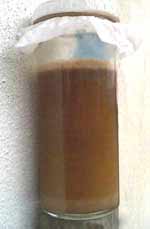I sampled one of the jars and found it tasted like beer ... a little fizzy ... so I decided to bottle one of the jars as is, with nothing further added to it, though it seems like I should be doing more to it. But I'll see how it turns out. The way I bottled it was to put it in a clean wine bottle, stop it with a plastic cork, and over that put a large plastic sandwich baggie, secured snugly with a sturdy elastic band. That way, if the beer throws the plastic cork out it will be caught in the baggie, and won't be spoiled by any contamination. I would just replace the cork and let it ferment a bit more. I have used this baggie-and-elastic-band trick with wine making, and I found that if it did blow out the stopper and foam out over the bottle, the baggie would trap the overflow as well and I could just pour it back in the bottle and nothing was lost.
An empty champagne bottle with a replaceable stopper would be ideal for this, because they're made to withstand pressure from the fermentation, but, as I don't have an empty champagne bottle with a replaceable stopper, a wine bottle is what I shall use. A wine bottle with a regular cork would probably work, too, though if that is what I had to use I would wrap the cork with thin plastic film before stuffing it in the bottle.
If you were doing this at home and didn't have a bottle or corks to use, you can always use a regular screw-on metal lid on a jar, however the risk here is that if the pressure builds up too much it could explode, so if I were going to do that, I would put the jar in a plastic bag (to contain the spillage) and put the bag in a cardboard box to stop the outward force, and maybe put the whole apparatus in a large plastic garbage bag as extra insurance. Then just check the jars a little more regularly to see how it is coming. If you get a big "whoosh" when you unscrew it, and the liquid is fizzy when you dirnk it, you can drink it then.)


